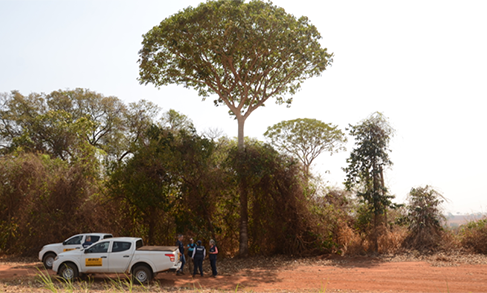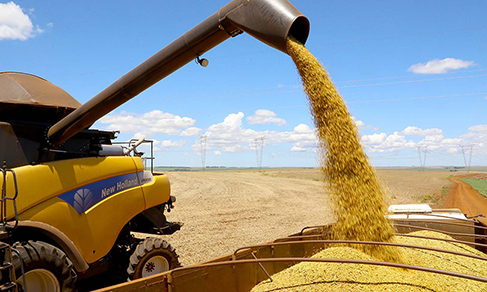Vital Statistics
In 2023, deaths fall 7.9% among elderly persons aged 80 years and over
May 16, 2025 10h00 AM | Last Updated: May 23, 2025 09h45 AM
Highlights
- Brazil registered 1.43 million deaths occurred in 2023, a figure 5% lower than that in 2022. The biggest drop was in the group of elderly persons aged 80 years and over (-7.9% or 38,035 deaths).
- In 2023, Brazil recorded 2.52 million births in the year, a drop of 0.7% in relation to 2022, the fifth retreat in a row.
- Number of marriages retreated 3% in 2023, adding up to 940.8 thousand; same-sex marriages hit a new record, with 11.2 thousand, an increase of 1.6%.
- Number of divorces increased 4.9% in 2023, hitting 440.8 thousand
- To check the under-registration of births and deaths, the IBGE researchers match the databases of Vital Statistics and those of the Ministry of Health, applying the capture and recapture model to disaggregate these indicators.
- In 2023, the estimated percentage of under-registration was 1.05% of the births occurred in the year, the lowest one in the time series started in 2015. The highest percentage was recorded in the North Region (3.73%), followed by the Northeast (1.49%).
- Live births from mothers aged under 15 years showed the highest percentage of under-registration (6.57%) compared with other ages.
- In 2023, the estimated proportion of under-registration of deaths in Brazil was of 3.55%, also highlighted by the North (12.29%) and Northeast (7.83%) regions.
- Concerning the age of the deceased, the highest estimates of under-registration were noticed for neonatal deaths (up to 27 days of life, 12.03%) and post-neonatal (between 28 and 364 days of life, 10.19%).

In 2023, registration of deaths falls 5.7% among persons aged 60 years and over, group that represents 71% of deaths occurred in the year and registered - Picture: Itapevi City Hall
1.43 million deaths occurred in Brazil in 2023, registered up to the first quarter of 2024, a reduction of 5% compared with the previous year. The biggest drop was in the group of elderly persons aged 80 years and over (-7.9%0, which is equivalent to a reduction of 38,035 deaths. The data are from Vital Statistics, released today (16) by the IBGE.
The group of elderly persons in general (persons aged 60 years and over) represented 71% of the deaths registered, which corresponds to 1.01 million deaths of elderly persons. Compared with 2022, it dropped 5.7% (less 61,272 deaths).
Klívia Brayner, Manager of Vital Statistics, points out the presence of residual deaths due to Covid-19. The World Health Organization (WHO) determined the end of the Public Health Emergency of International Concern (PHEIC) only in May 2023. "We can take a look at the information of the Ministry of Health´s Information System on Mortality (SIM/MS) and see that most of the drop in the number of deaths is related to the end of the pandemic. It is a very important drop, as we are returning to the pre-pandemic levels." According to SIM, there was a drop of 55.7 thousand deaths classified under the category "Virus diseases of unspecified localization", related to Covid-19.
The reduction in the number of deaths occurred in all the Major Regions and in 23 Brazilian Federation Units. The biggest drops in the number of deaths were noticed in the South (-8.0%) and Northeast (-5.3%) regions. The North Region registered the smallest relative drop (-2.3%). Concerning the Federation Units, the drops above 10% in Paraíba (-11.8%) and Rio Grande do Sul (-10.2%) stand out.
In the comparison by sex, 783 thousand male deaths and 646 female deaths occurred and were registered in 2023. The reduction in the number of male deaths was of 4.9% in relation to the previous year and that of female, of 5.2%. Therefore, the ratio of deaths between sexes increased from 120.8 to 121.2 male deaths per every 100 female deaths.
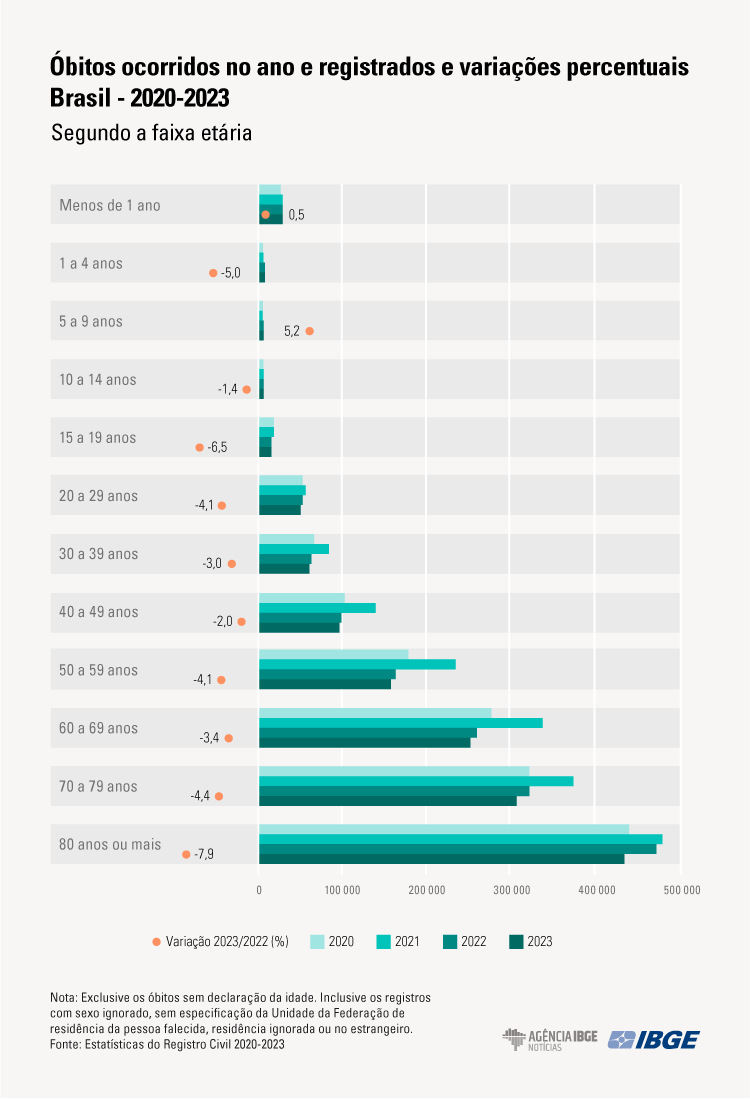
Number of births falls for the fifth year in a row
In 2023, Brazil recorded 2.52 million births in the year, a drop of 0.7% in relation to 2022, when 2.54 million births were registered. It is the fifth consecutive retreat in the time series, which started in 1974.
The survey points out a decrease in the number of birth registrations in all the Major Regions, except for the Central-West, which increased 1.1%. Among the Federation Units, 18 dropped, highlighted by Rondônia (-3.7%), followed by Amapá (-2.7%), Rio de Janeiro (-2.2%), Bahia (-1.8%) and São Paulo (-1.7%). Among nine FUs that rose, Tocantins (3.4%) and Goiás (2.8%) stood out.
A total of 2.60 million births were recorded in 2023, most of them (2.52 million) corresponding to children born in 2023 and registered up to the first quarter of 2024, in accordance with the legislation. On the other hand, 75 thousand records (2.9%) were births occurred in previous years or in an ignored year, and more than 63% of these records are of people living in the North and Northeast regions.
In 2023, 87.7% of the birth records in Brazil were registered in the deadline of up to 15 days and 98.8% of up to 90 days. The areas with more than 20% of the records registered after 90 days are concentrated in 16 municipalities, being 12 of them belonging to the North Region, three to the state of Piauí and one to the state of Mato Grosso.
In 2023, mothers aged 30 years and over accounted for 39% of births registered
Like the reduction of natality and fertility, aging of the fertility pattern has been pointed out over the last Population Censuses, comments Klívia Brayner. It is noticed in the increase in the number of birth records produced by older women.
Between the years of 2003 and 2023, the representativeness of births conceived by mothers aged between 30 and 34 years increased from 14.6% to 21.0% of the total number of births. For births conceived by mother aged between 35 and 39 years, the change rose from 7.2% in 2003 to 13.7% in 2023.
The number of births conceived by teenagers aged up to 19 years decreased in Brazil, changing from 20.9% in 2003 to 11.8% in 2023. Despite the significant proportions, the retreat occurred in all the Major Regions, especially in the North (18.7%) and Northeast (14.3%) regions.
The majority (25.5%) of births registered in 2023 were conceived by mothers aged between 25 and 29 years at the time of the delivery. It corresponds to 641,180 records. It was followed by the group aged between 20 and 24 years, with 594,235 births (23.6%) and that showed a significant retreat: the percentage changed from 31.1% in 2003 to 25.5% in 2013, decreasing to 23.6% in 2023.
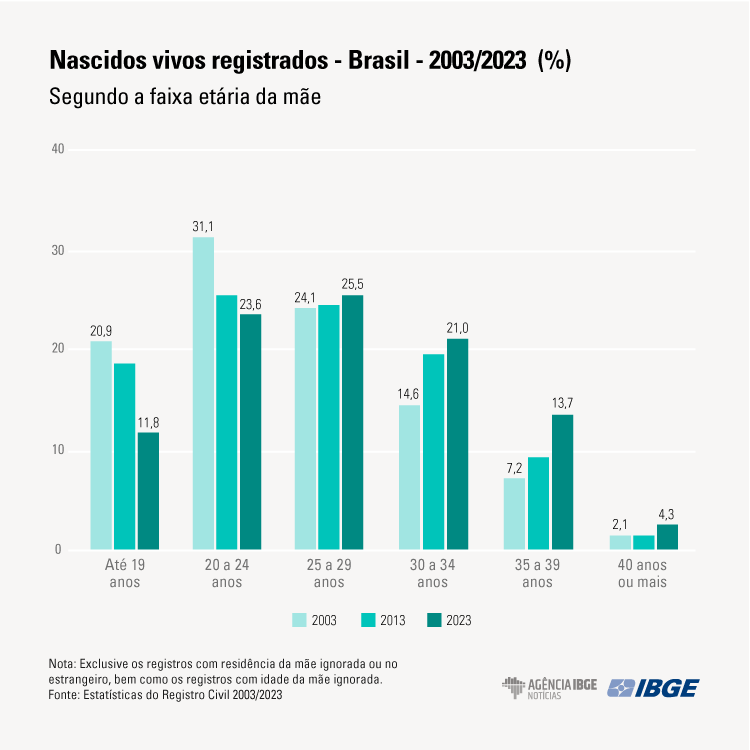
Number of marriages retreats 3% in 2023; same-sex marriages hit a new record
The survey showed that the number of marriages retreated 3% in 2023, adding up to 940.8 thousand records. The Major Regions followed the drop, except for the Central-West Region, which increased 0.8%. The biggest reduction occurred in the Southeast Region (-5.0%).
Of the total, only 11.2 thousand were same-sex marriages, an increase of 1.6% in relation to 2022. It is also a new record in the time series since 2023, when the National Council of Justice (CNJ) prevented notary offices to refuse to register same-sex marriages. Of the 11.2 thousand, most of them (62.7%) were between female partners. Marriages between women increased 5.9% from 2022 to 2023, though the number of marriages between men reduced 4.9% in the same period.
The ages of partners in marriages persons of different sexes increased over the last years, both for men and for women. In 2003, 8.2% of women who married were aged 40 years and over. In 2023, 25.1% of the records of civil marriages between persons of different sexes occurred with women in that same age range. That phenomenon was also noticed among men, with an increase of 18.3 percentage points in the share of marriage record in which men were older (40 years and over), comparing the years of 2003 (13.0%) and 2023 (31.3%).
The increase in marriage age might be related to the postponement of the decision for civil marriage and to the increase in the number of remarriages, since the extension in life expectancy contributes to this scenario as well. Brayner also highlights that the survey does not include stable unions, as it captures only civil marriages.
"The drop in the marriage records does not necessarily mean that people are not coupling anymore. The marital status of a person might be different from the civil status. It is possible that marriages are decreasing because people prefer stable unions rather than marriages. So, we need to take that into account when we do the analysis," says Brayner.
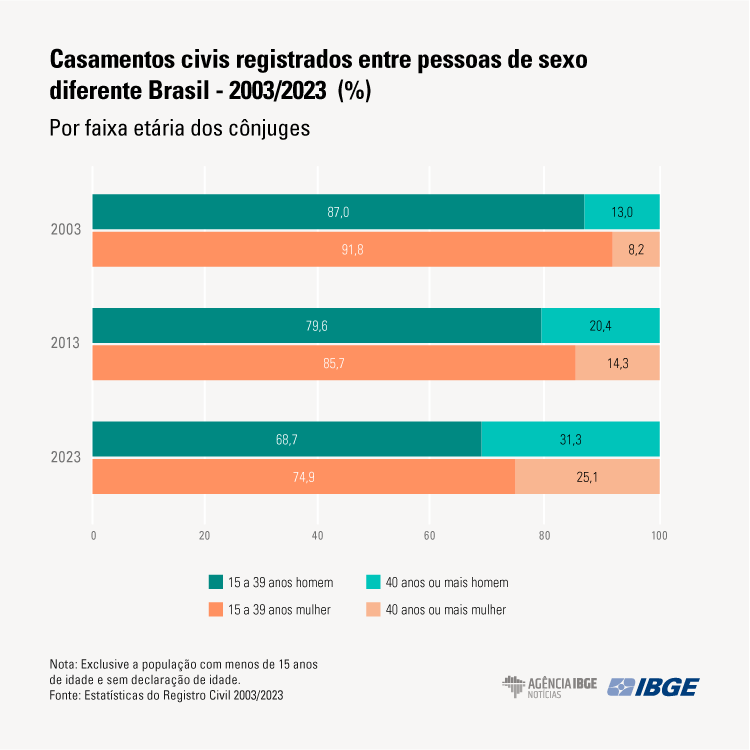
Number of divorces increases 4.9% in 2023 and surpasses 440 thousand
In 2023, Vital Statistics accounted for 440.8 thousand divorces granted in the first instance or through out-of-court deeds, an increase of 4.9% in relation to 2022 (420 thousand). The Central-West and North regions showed the highest changes, 16.8% and 13.1%, respectively.
On average, men divorced at later ages (44.3) than women (41.4). For every 100 marriages registered, nearly 47.4 divorces occurred in Brazil between persons of different sexes. The average time between the marriage date and the date of the divorce decree in 2023 was 13.8 years. It was nearly 16 years in 2010.
Legal divorces granted in the first instance corresponded to 81.8% of the Brazilian divorces. In the analysis of this type of divorce according to the family arrangement, the highest proportion of dissolutions occurred among families comprising infant children only, hitting 46.3% in 2023.
Under-registration of births drops, highlighted by the North Region
The IBGE also released today (16) the Under-Registration Estimates of Births and Deaths 2023. The data were obtained by matching the IBGE´s Vital Statistics and the databases of the Ministry of Health (Information System on Live Births - SINASC and Information System on Mortality - SIM).
"The study of the coverage of vital statistics allows the development of policies to reach the universalization of civil register and provide full access to citizenship, as well as assisting in the improvement of vital statistics and population indicators," explains José Eduardo Trindade, an analyst of the IBGE´s Division of Population and Social Indicators.
In 2023, the percentage of under-registration of births was 1.05%, the lowest one in the time series started in 2015. In 2022, the percentage had been 1.31%. In regional terms, the highest percentage of under-registration of live births was in the North, the region that mostly reduced this indicator, changing from 5.14% in 2022 to 3.73% in 2023. The other regions registered the following rates in 2023: Northeast, 1.49%; Central-West, 0.78%; Southeast, 0.31% and South, 0.19%.
It should also be highlighted that live births from mothers aged under 15 years recorded the highest percentage of under-registration (6.57%) compared with other ages. That percentage reduces with the increase in the age, hitting its lowest value in the range between 35 and 39 years (0.69%). "It has some explanations, like the lack of a supporting network to guide that teenager mother on the most suitable way to register her child," explains the analyst.
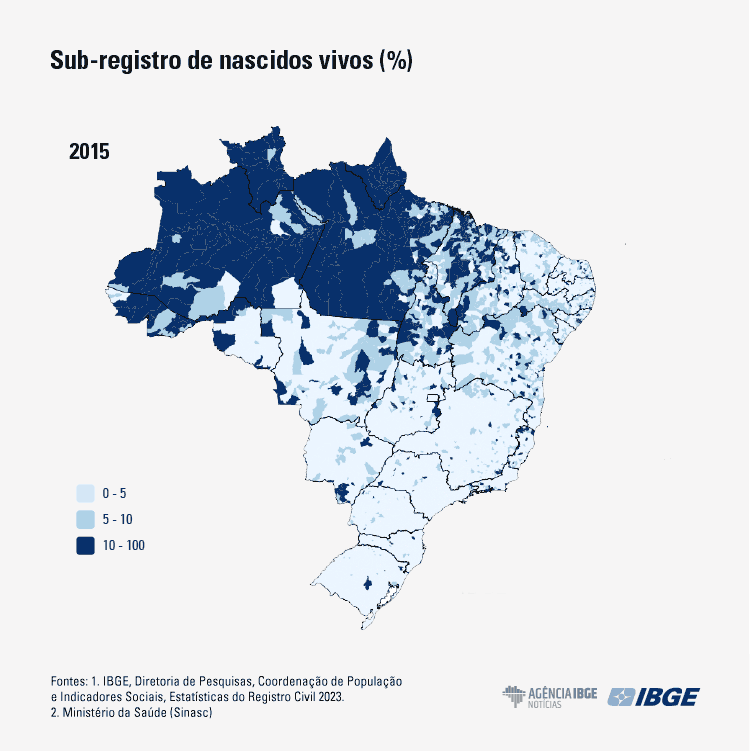
Under-registration of deaths maintains the level of 2022
In 2023, the proportion of under-registration of deaths was 3.55%, with a slight retreat of 0.1 p.p. in relation to the previous year. Like the under-registration of births, the North (12.29%) and Northeast (7.83%) regions stood out with the highest values.
Concerning the age of the deceased, the highest estimates of under-registration were noticed for neonatal deaths (up to 27 days of life, 12.03%) and post-neonatal (between 28 and 364 days of life, 10.19%). Maranhão (43.00%), Amapá (42.36%) and Piauí (33.02%) stood out as the states with the highest under-registration of deaths of those aged under 1 year.
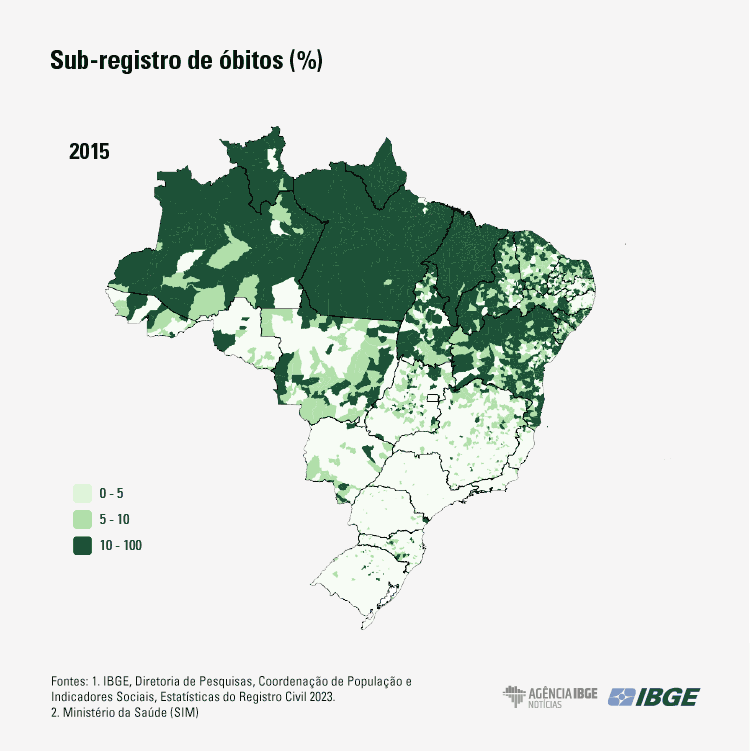
More on the surveys
The Vital Statistics survey gathers information related to live births, marriages, deaths and fetal deaths reported by the Civil Registry Offices of Natural Persons, to legal divorces reported by Family Courts, Forums or Civil Courts, as well as to out-of-court divorces accomplished by Notary Offices.
The Estimates of the Under-Registration of Births and Deaths are obtained by matching the IBGE´s Vital Statistics and the databases of the Ministry of Health (Information System on Live Births - SINASC and Information System on Mortality - SIM).


